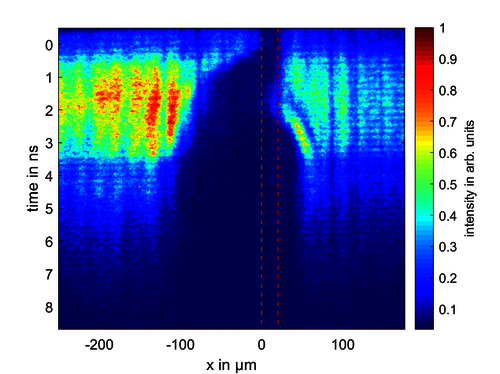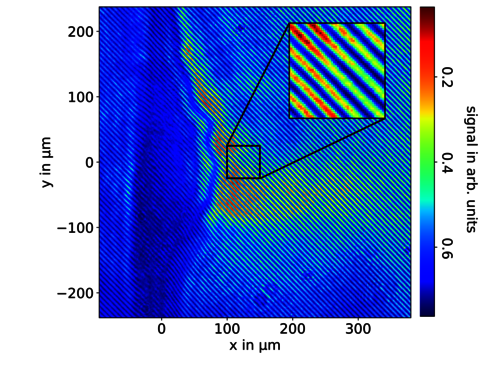SEPPL Backlighter Laser
Technical contact: Johannes Hornung
Der “Seeded Experimental Plasma Probe Laser” (SEPPL) ist ein mit PHELIX synchronisiertes Lasersystem mit nicht-harmonischer Wellenlänge und variabler Pulsdauer, welcher für Plasmauntersuchungen, welche z.B. über (zeitlich aufgelösten) Schattenwurf oder Interferometrie mit einem sehr hohen Signal zu Rauschen Verhältnis durchgeführt werden können.
SEPPL hat einen festgelegten Eintrittspunkt an der Targetkammer der PTA, welches sich an der westlichen Kammerwand, zwischen TB2 und TB3, auf einer Höhe von 360 mm über dem Kammer-Breadboard befindet. Der motorisierte Spiegel vor dem Eintrittsfenster der Targetkammer ermöglicht die Justage des Strahls unter Vakuum.
Die Pulsdauer kann zwischen 3.5 ps (komprimierter Puls), 275 ps (gechirpter Puls) oder kontinuierlich zwischen 0.4 ns und 3.4 ns, bei einer Wellenlänge von 1030 nm, verstellt werden indem eine neuartige Möglichkeit, basierend auf einer Fabry-Perot Kavität, verwendet wird um den Seed-Puls zu modulieren. Zusätzlich ist es möglich die Verstärkerkavität von SEPPL zeitlich zu überladen, womit Pulsdauern bis zu 10 ns erreicht werden können. Abhängig von der gewählten Pulsdauer, verändert sich die zeitliche Form des Pulses von Gauß artig, für den Pikosekunden-Puls und die überladene Verstärkerkavität, zu einer exponentiell abfallenden Form zwischen 0.4 ns und 3.4 ns. Außerdem muss erwähnt werden das der Nanosekunden-Puls schnelle zeitliche Oszillationen (>= 1.7 GHz) enthält welche unter der Verwendung von langsamen Detektoren nicht sichtbar sind. Ein Beispiel für verschiedene Längen der Fabry-Perot Kavität und ein überladener Verstärker, bei einer Wellenlänge von 1030 nm, sind in der folgenden Abbildung sichtbar.

Eigenschaften | Originale Wellenlänge | Frequenzverdoppelt |
Zentrale Wellenlänge | 1030 nm | 515 nm |
Pulsedauer (FWHM) | 3.5 ps, 275 ps oder 0.4 ns – 10 ns | ≈ Original/1.41 |
Signal zu PHELIX Emissionsverhältnis | nicht gemessen | > 110 |
Zeitliche Pulsform | Gaussartig < 0.4 ns & > 4 ns, sonst exponentiell abfallend | |
Energy (stark abhängig vom Aufbau!) | ≤ 7 mJ | ≤ 2 mJ |
Energystabilität über 45 Minuten | < 5 % RMS | < 5 % RMS |
Zeit-Schwankungen zum PHELIX Puls | < 1.95 ps | |
Mögliche Verzögerungen zum PHELIX Puls | ± 2.4 ns (schiebbar bis zu ± 200 ns) | |
Wiederholrate | 10 Hz, kontinuierlich | |
Beispiel des zeitlich aufgelösten Schattenwurfs (seitliche Ansicht) eines künstlichen Nanosekunden-Vorpulses, welches mit einer SEPPL Pulsdauer von 3.2 ns (@ 515 nm) mit einem Zeitfenster von 10 ns (Hamamatsu C10910) aufgenommen wurde.

Beispiel der Interferometrie (seitliche Ansicht) eines künstlichen Nanosekunden-Vorpulses, welches mit einer Pulsdauer von 2.5 ps (@ 515 nm) aufgenommen wurde. Die Vergrößerung zeigt die interferometrischen Modulationen welche genutzt werden können um die Elektronendichte des Plasmas, bis zu einer Maximaldichte von 5×1020 1/cm³, zu rekonstruieren.

Eine detailliertere Beschreibung des Lasersystems kann in der folgenden Publikation gefunden werden:
Hornung, J. et al. ‘Synchronized off-harmonic probe laser with highly variable pulse duration for laser–plasma interaction experiments’, High Power Laser Science and Engineering, 12, p. e10. (2024) doi:10.1017/hpl.2023.93






